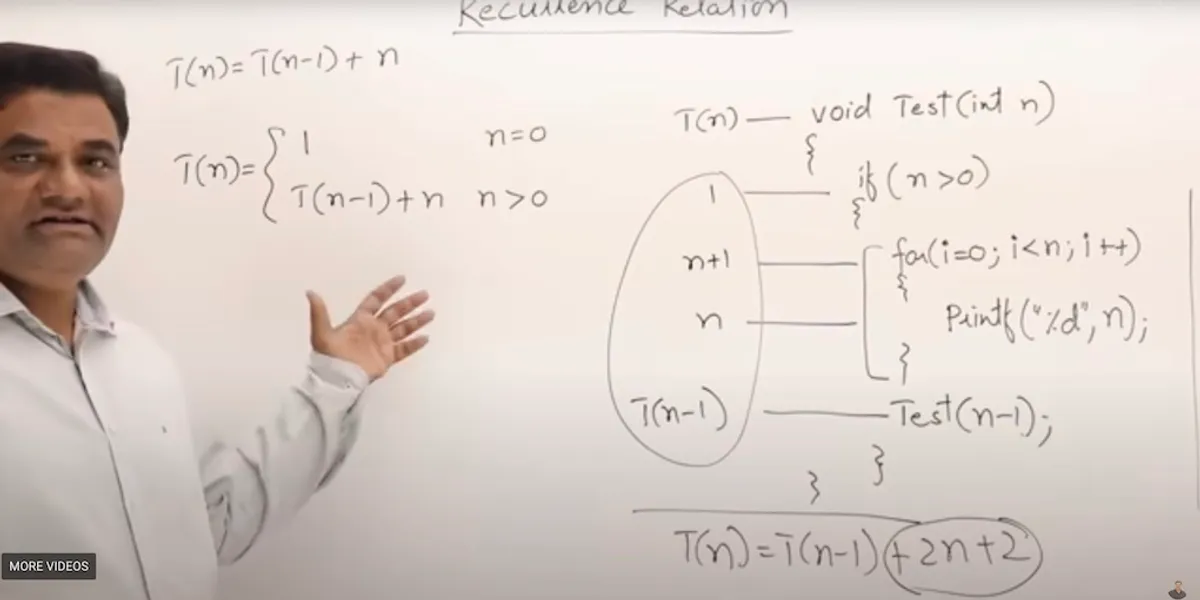Abdul Bari Algorithms - Recurrence Relation and Master's Theorem for Subtracting Functions
Discusses the recurrence relation, which is a mathematical notation to describe a sequence of values based on the previous term, which is useful for describing recursion and time complexity.


Divide and Conquer
If a problem is large, divide the problem into subproblems, solve them, then recombine the solutions
The subproblems should be the same type of problems, for example, if the main problem is sorting, then the subproblems are sorting
Examples of Divide and Conquer Problems
Binary search
Finding Maximum and Minimum
Merge Sort
Quick Sort
Strassen’s Matrix Multiplication
Subtraction Recurrence Relation 1
Recursive function example
function test(n) {
if (n > 0) {
console.log(n);
test(n - 1);
}
}How many times is this function called?
test(3) -> prints “3”
test(2) -> prints “2”
test(1) -> prints “1”
test(0) -> does not print, or call itself again, since n is not greater than 0
Does work (printing) 3 times, but calls itself 4 times, where it doesn’t print on the last time
If printing is one unit of time, then this takes 3 units of time
So if you pass n it will make n+1 calls, and print n times
The time depends on the number of calls, so time complexity is
How do we find the recurrence relation?
based on
The original equation
We know
We can find if we know
How do we find ?
based on
Let’s substitute into the equation for
Original equation
Substitute in place of in the original equation for
This simplifies to
Now we can substitute into the original equation for
This simplifies to
So now is in terms of instead of being based on
based on
We can keep doing this
What about in terms of ?
Substitute into original equation
This simplifies to
From before, we know how to write in terms of , so we plug it in to find in terms of
Previous equation: $T(n)=T(n-2)+2
Plug in based on
Simplifies to
What if we wanted to continue for times?
What is the smallest value we know,
Assume
Therefore
So when we can write the equation in terms of just
Simplifies to
We know
So
Subtraction Recurrence Relation 2
function test(n) {
if (n > 0) {
for (let i = 0; i < n; i++) {
console.log(n);
}
test(n - 1);
}
}Recurrence relation is
For each iteration, it takes units of time, then calls itself -1
Tree Method
We can see the amount of work is
To find the total amount of work we can use the integer-sum-formula
This simplifies to for measuring time complexity
Substitution Method
Original equation is
Plug in into original equation
Now we substitute this into the original equation to find in terms of instead of in terms of
Plug Plug in into original equation
Simplify to
If we continue this for times
Assume therefore
Substitute for
Simplify further
We can see is the sum of natural numbers, which we can use the integer-sum-formula to solve
And we know
So the answer is
Which simplifies to in Big O notation
Subtraction Recurrence Relation 3
function test(n) {
if (n > 0) {
for (let i = 1; i < n; i = i * 2) {
console.log(n);
}
test(n - 1);
}
}We know (let i=1; i< n; i=i*2) will execute times
Tree Method
Amount of work is
-> log n factorial
Equivalent to
Substitution method
Plug in n-2
Assume , therefore
Simplifies to
Directly Get Answer
->
->
->
->
Just multiply the term after the + by n, since you know it will be repeated n times via recursion
What if it’s not decreasing by 1? It still works
-> ->
->
However, if there’s a coeffecient on the function ,it’s different though.
Subtraction Recurrence Relation 4
function test(n) {
if (n > 0) {
console.log(n);
test(n - 1);
test(n - 1);
}
}
Tree Method
function called twice in first row
4 times in second row
8 times in third row
So the work done in each row is
In the series above, and
So we can use the formula above to find the answer for our tree
Simplifies to
Assume , so
So Big O is
Subsitution Method
Assume
Master’s Theorem for Subtracting Functions
->
->
->
->
->
->
Master’s Theorem
General form of recurrence relation
Assume
where
Case 1
For example
Then
also can be thought of as
Case 2
For example
Then
Case 3
If you’re decreasing by more than 1, for example
Then
What if for example .5
Then or